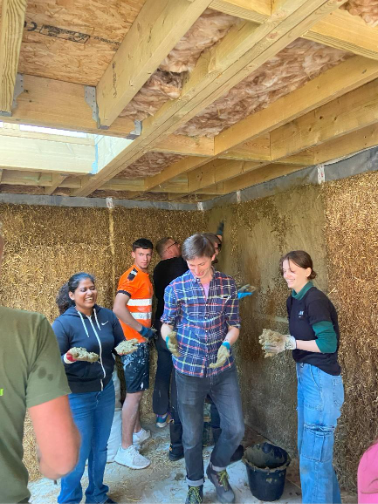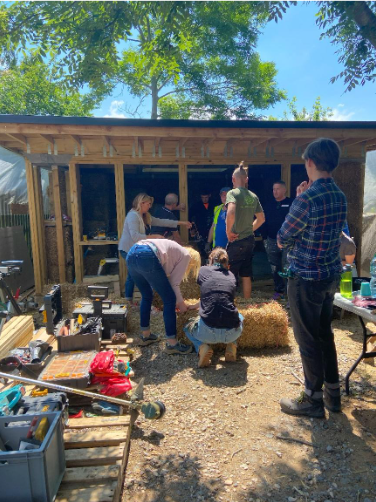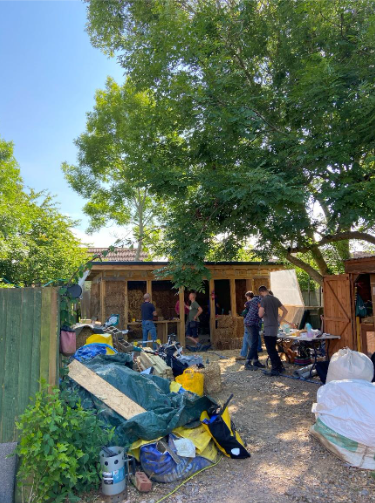Last month I attended a straw bale construction workshop with Grzegorz Gorski of Earth Safe Design, assisting with the construction of a ceramics workshop. The hands-on experience covered the whole build process from sizing the bales to applying clay plaster and timber cladding. Here I detail my well-established fascination with straw and the opportunities it presents for our built environment.
Why I love straw
Straw bales are incredible. If you’ve met me, there’s a very high chance I’ve spoken to you about straw.

Photograph by Sow Space.
I was first intrigued by its potential when I selected straw bale as the chosen material for a university design project in October last year. Through researching and exploring I became wholeheartedly obsessed with this natural material, and no number of books or construction details will ever satisfy my desire to keep learning more about straw.
Its ability to control internal air quality, effectively insulate spaces and lock up carbon are some of the many reasons I love straw bales. Available in both bale form and in panelised systems, there’s a straw bale construction solution for you.
As well as its abundant magnificent characteristics, I also love how using straw encourages the use of other natural and local materials. For example, the plaster we applied internally at the construction workshop was mixed using clay found on site whilst digging the foundations, which is about as local as you can get!
Furthermore, straw is very easy to recycle on site; we used offcuts from resizing the bales to pack into small gaps between the timber studs to ensure an uninterrupted thermal envelope. Where bales were re-tied and divided to create the necessary dimensions, the smaller leftover bales were set aside for use later in the construction.

Photograph by Sow Space.
Why you should love straw too
Straw is an agricultural waste product, which is widely available in the UK and often inexpensive. If that’s not enough to convince you, I have listed below some of its performance characteristics and what you can do as a designer to ensure it reaches its full potential.
What straw can do for you
Insulate effectively
Straw is a very good insulator and can provide U-values typical of Passivhaus buildings. Panelised systems have a more guaranteed and uniform thermal performance but that does not mean stacked bales perform badly: with a bit of careful attention paid to the thermal envelope your straw building will keep you toasty in the winter and lovely and cool in the summer. The material not only excels as thermal insulation but also provides excellent acoustic insulation.
Provide superb internal air quality
As a breathable (or hygroscopic) material, straw maintains a decent air quality within the building. It absorbs water vapour and slowly releases this over time as the internal humidity levels drop; effectively controlling the internal moisture levels. Furthermore, straw does not give off any harmful chemicals.
Lock up carbon
Straw sequesters carbon from the atmosphere as it grows. By weight, straw is approximately 40% carbon and this can be significantly increased by using regenerative agricultural practices.
Be load bearing or sit in a framed structure
There is more than just one way to build with straw. Straw bales can be stacked to form load bearing structures or can be inserted into a framed structure. Prefabricated panelised systems can be erected in a day and individual panels reused in their entirety if the building is disassembled.
Return to the ground
If the building is no longer needed, straw is entirely compostable.
What you can do for straw
Design with thick walls
Compared to synthetic alternatives, a greater depth of straw is needed to achieve low U-values. External walls can exceed 500mm, so consider this early on in the design process.
Choose your finishes carefully
In order for the straw to be able to effectively control the internal air quality, it needs to be able to breathe. Natural finishes such as lime and clay renders or paints also have hygroscopic properties, and other compatible finishes include timber rain screens.
Protect from moisture
The bale construction needs to start above ground level so it is protected from damp and splashback and a roof with an overhang will protect the bales from rain. Choosing breathable finishes will also allow moisture within the straw wall buildup to easily escape.

Photograph by Sow Space.
Excellent, what do I do now with my newfound love for straw?
I hear you clamour. Fear not. Why not research straw construction; read some books (this is a good one), look at some websites and generally immerse yourself in the wonderful world of straw. I would recommend looking into Barbara Jones and what she has written. Maybe there is a straw bale building near you: go and visit! If you want to get your hands on some straw and have a go yourself, have a look for workshops and other opportunities to get stuck in.
Happy baling!

